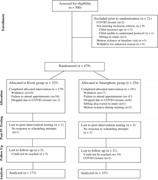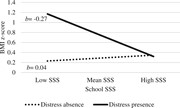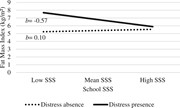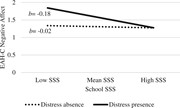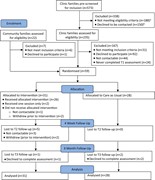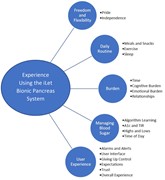1-20 of 6186
Sort by
Image
CONSORT flowchart of study enrollment. Note. VR=virtual reality.
Get access

in
Journal of Pediatric Psychology
>
Teaching children pedestrian safety in virtual reality via smartphone: a noninferiority randomized clinical trial
Published: 18 April 2024
Figure 1.
CONSORT flowchart of study enrollment. Note . VR=virtual reality.
Journal Article
Lower subjective social status is associated with increased adiposity and self-reported eating in the absence of hunger due to negative affect among children reporting teasing distress
Bobby K Cheon and others
Journal of Pediatric Psychology, jsae024, https://doi.org/10.1093/jpepsy/jsae024
Published: 18 April 2024
Image
Kiosk VR results-unsafe crossings. Note. VR=virtual reality.
Get access

in
Journal of Pediatric Psychology
>
Teaching children pedestrian safety in virtual reality via smartphone: a noninferiority randomized clinical trial
Published: 18 April 2024
Figure 3.
Kiosk VR results-unsafe crossings. Note . VR=virtual reality.
Image
Subjective social status (SSS) and teasing distress interaction on BMI as a...
in
Journal of Pediatric Psychology
>
Lower subjective social status is associated with increased adiposity and self-reported eating in the absence of hunger due to negative affect among children reporting teasing distress
Published: 18 April 2024
Figure 1.
Subjective social status (SSS) and teasing distress interaction on BMI as age- and sex-adjusted z-scores (BMIz), b =−0.31, t =−2.45, 95% CI: −0.50, −0.11. Lower SSS is associated with higher BMIz only when participants reported experiencing teasing distress, b =−0.27, t =−2.52, bootstrapped 95%
Journal Article
Teaching children pedestrian safety in virtual reality via smartphone: a noninferiority randomized clinical trial
Get access

David C Schwebel and others
Journal of Pediatric Psychology, jsae020, https://doi.org/10.1093/jpepsy/jsae020
Published: 18 April 2024
Image
Smartphone VR results-unsafe crossings. Note. VR=virtual reality.
Get access

in
Journal of Pediatric Psychology
>
Teaching children pedestrian safety in virtual reality via smartphone: a noninferiority randomized clinical trial
Published: 18 April 2024
Figure 2.
Smartphone VR results-unsafe crossings. Note . VR=virtual reality.
Image
Subjective social status (SSS) and teasing distress interaction on fat mass...
in
Journal of Pediatric Psychology
>
Lower subjective social status is associated with increased adiposity and self-reported eating in the absence of hunger due to negative affect among children reporting teasing distress
Published: 18 April 2024
Figure 2.
Subjective social status (SSS) and teasing distress interaction on fat mass index (FMI), b =−0.66, t =−1.88, 95% CI: −1.24, −0.08. Lower SSS is associated with higher FMI only when participants reported experiencing teasing distress, b =−0.57, t =−1.86, bootstrapped 95% CI: −1.09, −0.02.
Image
Subjective social status (SSS) and teasing distress interaction on child-re...
in
Journal of Pediatric Psychology
>
Lower subjective social status is associated with increased adiposity and self-reported eating in the absence of hunger due to negative affect among children reporting teasing distress
Published: 18 April 2024
Figure 3.
Subjective social status (SSS) and teasing distress interaction on child-reported eating in the absence of hunger (EAH-C) due to negative affect, b = −0.16, t =−2.20, 95% CI: −0.28, −0.04. Lower SSS is associated with higher EAH-C due to negative affect only when participants reported experiencin
Journal Article
Empirically derived profiles of neurocognitive functioning in youth and young adults with sickle cell disease
Get access

Vinkrya Ellison and others
Journal of Pediatric Psychology, jsae029, https://doi.org/10.1093/jpepsy/jsae029
Published: 16 April 2024
Image
Neurocognitive profiles of youth and young adults with sickle cell disease ...
Get access

in
Journal of Pediatric Psychology
>
Empirically derived profiles of neurocognitive functioning in youth and young adults with sickle cell disease
Published: 16 April 2024
Figure 1.
Neurocognitive profiles of youth and young adults with sickle cell disease based on latent profile analysis. Dashed-line: exceptionally low functioning class ( n = 47, 12%), dotted-line: low average functioning class ( n = 237, 60%), average functioning class ( n = 107, 27% of study sample)
Journal Article
Commentary: Lost in Transition? Future Directions for Healthcare Transition Research with Rare Diseases
Get access

Taylor M Dattilo and Larry L Mullins
Journal of Pediatric Psychology, jsae030, https://doi.org/10.1093/jpepsy/jsae030
Published: 13 April 2024
Image
CONSORT diagram of flow of participants. aClinically ineligible ...
in
Journal of Pediatric Psychology
>
Brief parenting intervention (Triple P) for families of children with eczema: a randomized controlled trial
Published: 10 April 2024
Figure 1.
CONSORT diagram of flow of participants. a Clinically ineligible families screened out by clinic staff (no eczema diagnosis, n = 100; not prescribed topical corticosteroids, n = 8); another 80 families excluded by the research assistant (insufficient English, n = 30; lived too far away, n =
Journal Article
Brief parenting intervention (Triple P) for families of children with eczema: a randomized controlled trial
Amy E Mitchell and others
Journal of Pediatric Psychology, jsae023, https://doi.org/10.1093/jpepsy/jsae023
Published: 10 April 2024
Journal Article
Parent, child, and adolescent lived experience using the insulin-only iLet Bionic Pancreas
Get access

Kelsey R Howard and others
Journal of Pediatric Psychology, jsae022, https://doi.org/10.1093/jpepsy/jsae022
Published: 09 April 2024
Image
Themes and sub-themes of the BP clinical trial.
Get access

in
Journal of Pediatric Psychology
>
Parent, child, and adolescent lived experience using the insulin-only iLet Bionic Pancreas
Published: 09 April 2024
Figure 1.
Themes and sub-themes of the BP clinical trial.
Journal Article
Commentary: JPP Student Journal Club Commentary: Knowledge as necessary but not sufficient for improving self-management in pediatric chronic illness
Get access

Sarah M Schellhaas and Rachelle R Ramsey
Journal of Pediatric Psychology, jsae028, https://doi.org/10.1093/jpepsy/jsae028
Published: 08 April 2024
Journal Article
The Maintain High Blood Glucose subscale of the child hypoglycemia fear survey: proposed preliminary cut points for screening youth with type 1 diabetes
Get access

Holly K O’Donnell and others
Journal of Pediatric Psychology, jsae021, https://doi.org/10.1093/jpepsy/jsae021
Published: 08 April 2024
Journal Article
Predictors of adherence to a brief sleep extension protocol in emerging adults
Get access

Isabella D Wright and others
Journal of Pediatric Psychology, jsae025, https://doi.org/10.1093/jpepsy/jsae025
Published: 05 April 2024
Journal Article
Exploratory factor analysis of the Illness Intrusiveness Rating Scale for parents of children with atypical genital appearance due to differences of sex development (DSD)
Get access

Alexandra M DeLone and others
Journal of Pediatric Psychology, jsae027, https://doi.org/10.1093/jpepsy/jsae027
Published: 05 April 2024
Journal Article
Child routines moderate a brief behavioral intervention to enhance sleep in school-aged children
Get access

Azeb Gebre and others
Journal of Pediatric Psychology, jsae015, https://doi.org/10.1093/jpepsy/jsae015
Published: 29 March 2024
Advertisement
Advertisement



